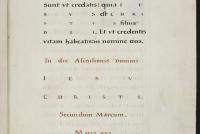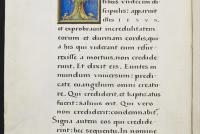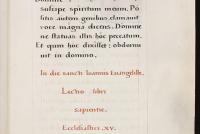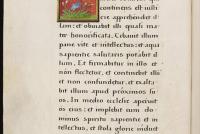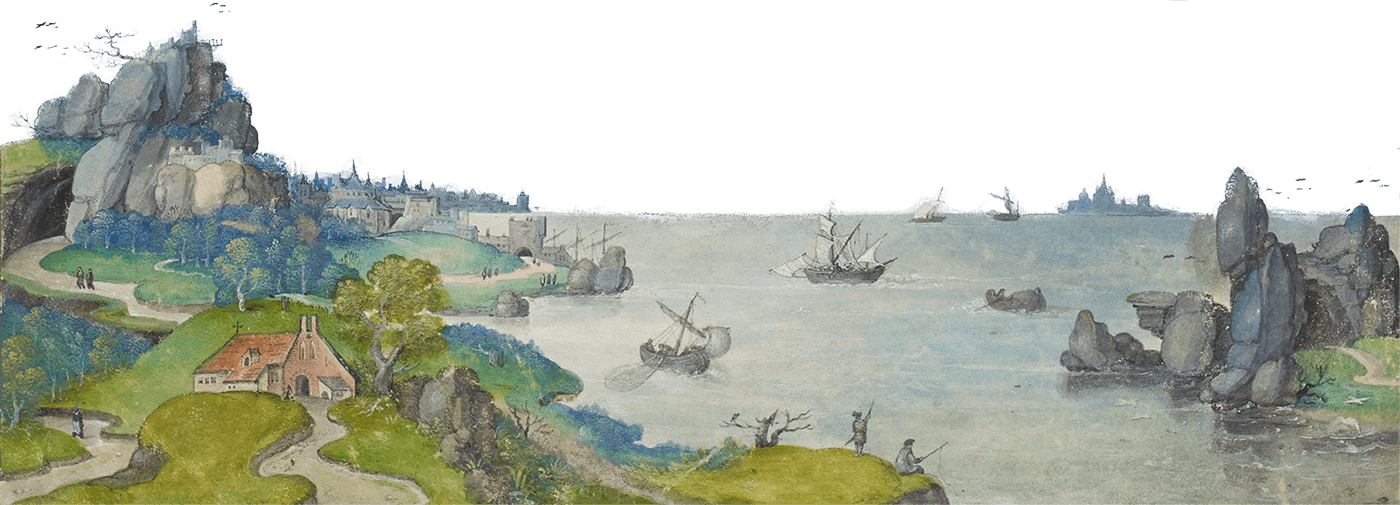The Lectionary and the Liturgy
Published on 11/05/2017 | Originally published 2005, draft for a CD-ROM
Wolsey’s lectionary is a witness to a liturgy soon to be transformed by the Reformation. This series of European-wide upheavals was already breaking out as the lectionary-book was being made. For a thousand years before, the worship of the Western Church had followed the rhythms which structure Wolsey’s book: a kaleidoscope of shifting liturgical moods, playing out a central drama portraying the life of Christ, but also hosting a series of lesser vignettes which centred on the lives and personalities of God’s servants, the saints. At the centre of it all was the Church’s greatest liturgical act, the Mass, or Eucharist. This was a return to Christ’s Last Supper with his disciples before his sufferings, at which he had broken bread and offered wine. The medieval Western Church told a particular story about this drama: it was the sacrament and sacrifice of Christ’s body and blood in bread and wine. The mass in late medieval Catholic Christianity had become the kingpin in a system providing a majestic and satisfying answer to one of the central anxieties of mainstream Christian faith: how to be saved to enter the joys of heaven.
Early in Christian history, the brutal Christian simplicities of heaven and hell aroused unease; hell seems an extreme fate for most people’s sins, while ordinary life generally provides few virtues unsullied enough to act as automatic qualifications for heaven. By the twelfth century the Western Church was meditating on earlier ideas about an intermediate state of purging preparatory to entry on eternal bliss. It systematised them into the concept of a state or place known as purgatory. Purgatory was one of the great success stories of Christian theological construction, and the mass, as the central act of the Church’s constant offering of prayer, quickly became associated with this bumpy but reasonably secure road to salvation. Here was prayer which the living could offer to speed the dead on their way: the more prayer the better, and hence the more masses the better.
A performance of a mass needed a priest to say or sing it: to consecrate the two elements by prayer, and so to offer the sacrifice of Christ’s body and blood. Although the medieval Church formalised a whole series of minor orders beyond the three clerical orders of bishop, priest and deacon, the role of the ordained priest in the mass was crucial to the medieval system of salvation, a role which effectively separated him from the layperson. This separation became such that the laity were reduced to passive spectators of the mass, rarely receiving the consecrated elements, which were normally consumed by the priest alone. The nature of the priest’s role decided the priorities in people’s expectations of him: it helped if his personal character and behaviour were admirable - achieving this was one of the aims behind the imposition of universal celibacy in the medieval Western Church - but less admirable priests were no less able to offer the sacrifice. Nor did the priest have to be particularly clever or articulate, able to instil fresh fire in the laity’s understanding of Christian faith: as long as he could remember the sequence of actions and words of the local variant on the Latin rite of the mass, it was enough. That would nevertheless prove to be a problem when the Protestant Reformation forced priests to argue in defence of their ancient beliefs; most of them were no good at it, and their Church crumbled under ruthless official assault.
Monasteries were the specialists in the art of prayer, but from the earliest days of monasticism, the monks’ duties of prayer ran alongside the round of prayer and worship maintained by clergy in the everyday world of the laity. Like the rest of Western Europe, Anglo-Saxon England embarked on the task of systematising the Church’s duty of providing pastoral care for its members; it began mapping out a system of parishes, territorial units intended to be manageable enough for one or more ordained men to maintain an intimate pastoral relationship with the faithful. By the thirteenth century, England and Wales were provided with an all-embracing parish network. Clergy therefore carried out their round of prayer either in monastic (‘regular’) or non-monastic (‘secular’) life. During the thirteenth century, the work of the monasteries had been supplemented by Orders of friars, emphasising both intimate contact between their communities and laypeople and also the duty of communicating ideas about the Christian faith to the laity, particularly in the form of sermons.
Within this apparatus of production for prayer built up by the medieval Western Church, the balance of lay patronage shifted. The great age of lay investment in communities of monks, nuns and friars had been from the ninth to the thirteenth centuries; after that, with the network of parishes complete, the laity began looking to the secular clergy for their main supply of intercessory prayer. If they were wealthy, they might found non-monastic communities of priests (‘colleges’), such as those which Thomas Wolsey founded at Oxford and Ipswich to give his soul especially de luxe treatment in purgatory. Lesser investments could be made in the host of parish churches and chapels. Benefactions could be made to any church to offer a specific number of masses: from the speech-convention that masses were always sung (cantare: to sing), these foundations were called cantariae, or in English, chantries. Wolsey’s collegiate foundations were simply the largest version of a chantry. Chantries could be a separate building, a side-chapel in an existing church, or simply a legal obligation on the priest of a particular place; virtually all England’s 9000 parishes must have had some sort of soul-mass provision in the 1520s. Their functions shaded off into a whole host of lay associations, called variously gilds, brotherhoods, fraternities, confraternities; these were designed to further the production of prayer by financing a priest to say masses, particularly for the spiritual benefit of the members of the confraternity and those whom they knew.
To describe the centrality of the mass in late medieval piety is to paint too monochrome a picture of a bewildering variety of devotional expression. The mass was structured around familiar objects which anyone could comprehend, bread and wine; similarly, the medieval Church’s universal ceremony of membership, baptism, involved water, oil, salt and saliva. The Church had a genius for building on this capacity of Christianity to invest the everyday with sacred significance. Worship might involve a distant, all-powerful God, but God could be reached little by little through the familiar, the approachable: a picture, the image of God on the Cross above the central screen in almost every church, the image of a saint, the light which burnt in front of so many sacred places and objects. Light played a prominent part: the regular provision of votive candles before sacred objects was a constant concern for parish officials, and the pre-Reformation church interior would be a warm and smoky galaxy of small lights. Worship might be concentrated on the mass, but it was also diffused into a myriad devotions to saints and sacred places, and expressed in a passion for providing beautiful objects and sounds to open up access to the divine - sounds as well as objects, because bells and elaborate music were essential parts of this expression of pious energy.
This sacred world of the English people had not been constructed in isolation. Between the eleventh and thirteenth centuries successive Bishops of Rome, the only bishops in the West to retain the ancient respectful title of ‘Pope’, had built on the antiquity and unrivalled prestige of their see (diocese) among all other Western sees, to assume claims of universal overlordship. Although these claims never realised their full potential, they had produced a Western Church which was an international society with its own sophisticated and intimidatingly all-embracing law-code (‘canon law’), administered by church courts. The Pope could and did have a say in the appointments of English clergy; English lawsuits might be heard at Rome. The realm of England was not simply bound into the Catholic world through links to Rome; it was also a field for the activities of international religious corporations such as the Cistercian Order of monks, the Dominican or Franciscan Orders of friars or the Knights of the Hospital of St John of Jerusalem. The Catholic world of the pre-Reformation West thus had two pillars to support it: first, a devotional pattern centred on the power of the mass and the power of the clergy who performed it, and second, the unity provided by the Pope. Virtually no one in 1500 could have considered that Catholicism could stand without the combined support of these two pillars.
The sixteenth century Protestant reformers, however various their aims, all did their best to bring down both. When they read the Bible, they abandoned the preconceptions of the medieval Western Church as to how to understand it; this fresh reading convinced them that the old devotional pattern was a mischievous obstacle to true faith in God, particularly since its emphasis on purgatory could not be sustained on a straightforward reading of the Biblical text. That meant that the mass as understood by the Church was a blasphemous betrayal of the communion whose institution was described in the pages of scripture; so the centralised Roman authority which persisted in defending the traditional road to salvation must also be a traitor to the faith of Christ. Confident that their message must seem obvious on a reading of the Biblical text, Protestants insisted that the text should be available to all: it was the only road to faith in Christ, which was the only means of salvation. This central message of scripture must be explained constantly to humankind, now poised starkly and without the benefit of purgatory between heaven and hell, and the chief medium for doing it must be the sermon. The devotional world which Protestants sought to construct was thus dramatically simpler than the rich and untidy fabric of medieval Catholicism, and at its centre, in place of the sequence of actions and formal texts which made up the mass, was the apprehension of a set of ideas by the Christian believer, fortified by constant access to the Bible in reading or in sermons. The emphasis had shifted from objects and actions to words. The English Reformation proved rather less drastic than some elsewhere in Europe, and its vernacular Prayer Book crafted by Thomas Cranmer had more resemblances to the old liturgy than many Protestant forms of worship. Nevertheless it relegated books like Wolsey’s lectionary to being at best pleasing antique picture-books, and at worst, objects of the Devil, to be destroyed in case they polluted the world and corrupted the vulnerable. Countless books like this ended up on sixteenth-century bonfires.


